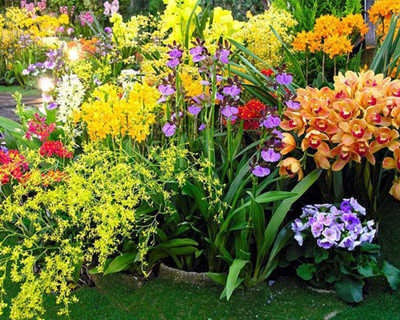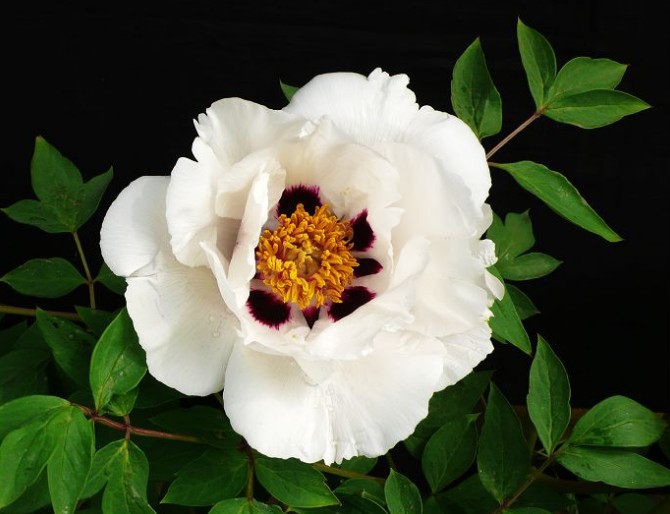Grasp the best watering time for flowers
The choice of watering time should try to make the water temperature close to the soil temperature. Under normal circumstances, the difference between water temperature and soil temperature is within 5 degrees Celsius, watering flowers is safer, and root damage will not occur. Specific to the daily watering time, spring, summer, autumn, winter are also different.
In spring, autumn and winter, about 10 a.m. and after 4 p.m. are the appropriate time for watering flowers.
Midsummer noon, the temperature is very high, the temperature of flower leaves can often be as high as 40 degrees Celsius, transpiration is strong, while water evaporation is also fast, the root system needs to constantly absorb water, supplement the loss of leaf transpiration, if poured cold water at this time, although the pot soil added water, but due to the sudden decrease in soil temperature, root hair by low temperature stimulation, will immediately hinder the normal absorption of water. At this time, because there is no preparation in the flower body, the leaf stomata are not closed, and the balance of water supply and demand is lost, resulting in the leaf cells becoming wilted from the tense state, causing the plant to produce "physiological drought", the leaves are scorched, and the whole plant will die when it is serious.

This phenomenon is particularly evident in herbaceous flowers, such as geranium, turnip, chrysanthemum, etc. The most taboo hot weather poured cold water at noon. Therefore, avoid watering flowers at noon in the hot summer.
The same reason, in winter morning and evening temperature difference is large, of course, should be at noon when the soil temperature and temperature are closer to watering flowers. Many flower growers are accustomed to watering in the evening, mistakenly thinking that this is the best, in fact, on the contrary, especially in winter or indoors, if watering at night, water loss is slow, it will increase the pot soil and air humidity and easily lead to flower infection disease and suffer from freezing injury.
Grasp the best watering time for flowers
The choice of watering time should try to make the water temperature close to the soil temperature. Under normal circumstances, the difference between water temperature and soil temperature is within 5℃, watering flowers is relatively safe, and root damage will not occur. Specific to the daily watering time, spring, summer, autumn, winter are also different.
In spring, autumn and winter, about 10 a.m. and after 4 p.m. are the appropriate time for watering flowers. Midsummer noon, the temperature is very high, the temperature of flower leaves can often be as high as 40℃, transpiration is strong, at the same time water evaporation is also fast, the root system needs to continuously absorb water, supplement the loss of leaf transpiration, if poured cold water at this time, although the pot soil added water, but due to the sudden decrease in soil temperature, root hair by low temperature stimulation, will immediately hinder the normal absorption of water. At this time, because there is no preparation in the flower body, the leaf stomata are not closed, and the balance of water supply and demand is lost, resulting in the leaf cells becoming wilted from the tense state, causing the plant to produce "physiological drought", and the leaves are scorched.
This phenomenon is particularly evident in herbaceous flowers, such as geranium, turnip, chrysanthemum, etc. The most taboo hot weather poured cold water at noon. Therefore, avoid watering flowers at noon in the hot summer. The same reason, in winter morning and evening temperature difference is large, of course, should be at noon when the soil temperature and temperature are closer to watering flowers. Many flower growers are accustomed to watering in the evening, mistakenly thinking that this is the best, in fact, on the contrary, especially in winter or indoors, if watering at night, water loss is slow, it will increase the pot soil and air humidity and easily lead to flower infection disease and suffer from freezing injury.
How to Water Flowers Properly
The quality of the pot soil and many other aspects to determine the size of the amount of watering. Watering is a very practical work, planting flowers is the first hurdle watering. So here are just some common watering methods.
(1)Seasonal differences in watering. The water requirements of most plants throughout the year are roughly: spring, plants gradually enter the vigorous growth period, watering should gradually increase, watering time should be carried out before noon. In summer, flowers grow vigorously, transpiration is strong, watering amount should be sufficient, watering time should be carried out in the morning or evening. After the beginning of autumn, due to the temperature drop, flowers grow slowly, should gradually reduce the amount of watering, watering time should be carried out before 10 am. Some flowers will grow twice in autumn, and sufficient water should be given at this time to avoid affecting the growth of new shoots. Winter, the temperature is low, many flowers into dormancy or semi-dormancy period, to strictly control the amount of watering, time should be 1~2 pm. In addition, the water temperature should be close to the soil temperature when watering, and the difference between the water temperature and the soil temperature should not exceed 5 degrees. Whether it is summer or winter, it is best to leave it overnight after receiving water. On the one hand, it can decompose and volatilize the bleaching substances in tap water. On the other hand, it is necessary to avoid excessive differences between water temperature and soil temperature, causing flowers to catch a cold.
(2)Correct timing of watering. The amount of potted flowers watered and the control of the dry and wet degree of potted soil largely determine the quality of flower growth. Generally speaking, basin soil surface white, dry hard water should be added. The soil color is dark, indicating that the water content is large and does not need watering. Can also be used to touch the surface of the basin soil, such as soil hard, with fingers pinch soil into powder, indicating that the basin soil has been dry, should be replenished; if the soil is soft, pinch basin soil was mud cake shape do not need watering. Potted flowers such as planting with earthen pots, available fingers or sticks tapping pot wall, if the sound is clear, the pot soil has dried, if dull, do not need watering. If planted in a plastic pot, the pot can be gently lifted with one hand. If the bottom of the pot is very light, it means lack of water; if it is heavy, it is unnecessary to water.
(3)Control of watering. Due to early days or leakage of irrigation and other reasons, the pot soil is too dry for a while, the potted flowers appear low branches, leaves atrophy, evergreen leaves are bright but not moist, leaf edges turn yellow and other phenomena, indicating that the plants lack too much water. At this time can not immediately water, should put the flowerpot in the shade, pour a small amount of water to the pot and spray water to the leaves, wait for the stems and leaves to straighten and then pour water, so as to prevent the roots and leaves from falling yellow. Too much watering makes the leaves droop, the tips of the leaves first appear dry, and then the edges turn yellow, indicating that waterlogging has occurred. If it cannot be treated in time, the yellow flowers will gradually die when 1/2 of the leaves of the plant appear. Potted flowers watering the main point is to see wet in, most of the flowers are required after the pot soil dry thoroughly watering, avoid watering the head water, half water.
- Prev

The method of fertilizing flowers and plants is not suitable.
Most of the newly planted plants were injured by □ without application of the newly planted plants. If they were stimulated by the outside world, they could not heal and cause rotting roots. If fertilization is not applied at flowering stage, it will cause bud drop, flower drop and fruit drop. If there is no application during the dormant period, the growth of flowers stops or slows down during the dormant period, slow metabolism and poor photosynthesis.
- Next

Culture methods and matters needing attention of Paeonia suffruticosa
Paeonia suffruticosa is an endemic plant in China. It is a precious flower germplasm resource and its root bark is used for medicine. Paeonia suffruticosa is a cold and dry ecotype with strong stress resistance and is suitable for low temperature and arid climate. Purple spot peony is scattered in Shaanxi, Gansu and western Henan. Due to the use of root bark as medicine, it has been overmined for a long time.
Related
- Fuxing push coffee new agricultural production and marketing class: lack of small-scale processing plants
- Jujube rice field leisure farm deep ploughing Yilan for five years to create a space for organic food and play
- Nongyu Farm-A trial of organic papaya for brave women with advanced technology
- Four points for attention in the prevention and control of diseases and insect pests of edible fungi
- How to add nutrient solution to Edible Fungi
- Is there any good way to control edible fungus mites?
- Open Inoculation Technology of Edible Fungi
- Is there any clever way to use fertilizer for edible fungus in winter?
- What agents are used to kill the pathogens of edible fungi in the mushroom shed?
- Rapid drying of Edible Fungi

